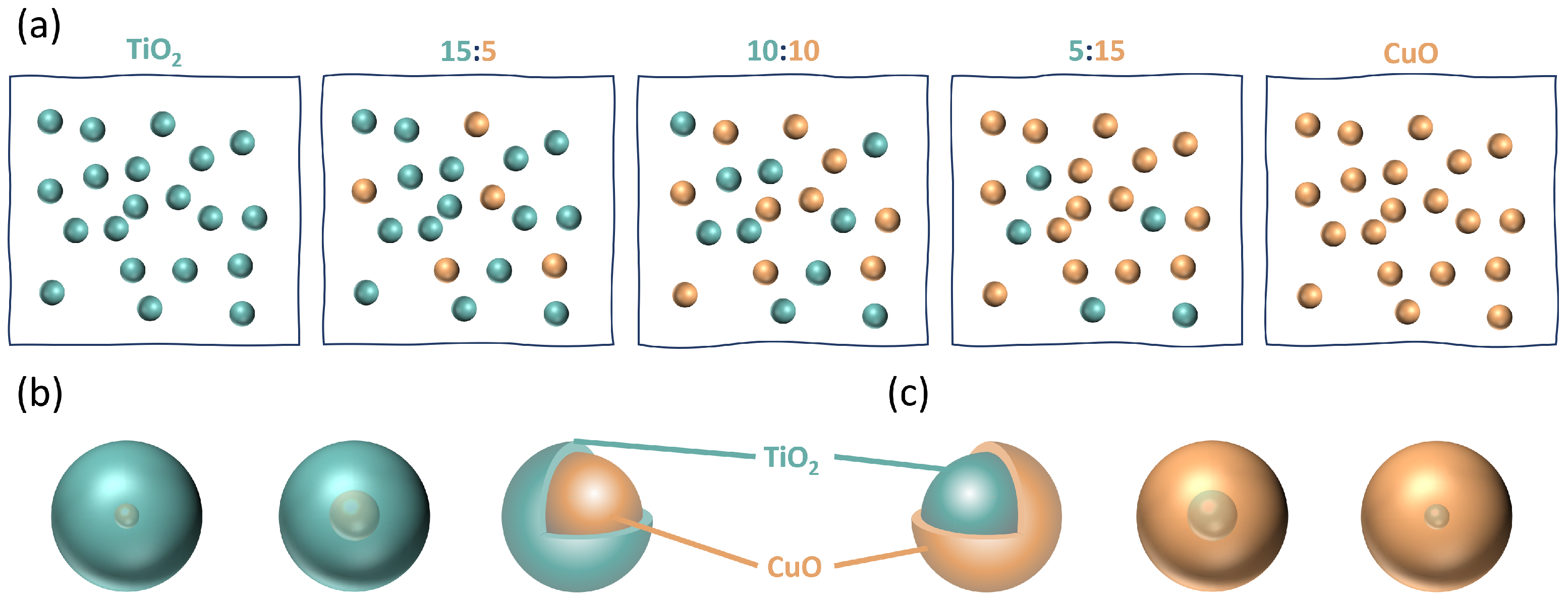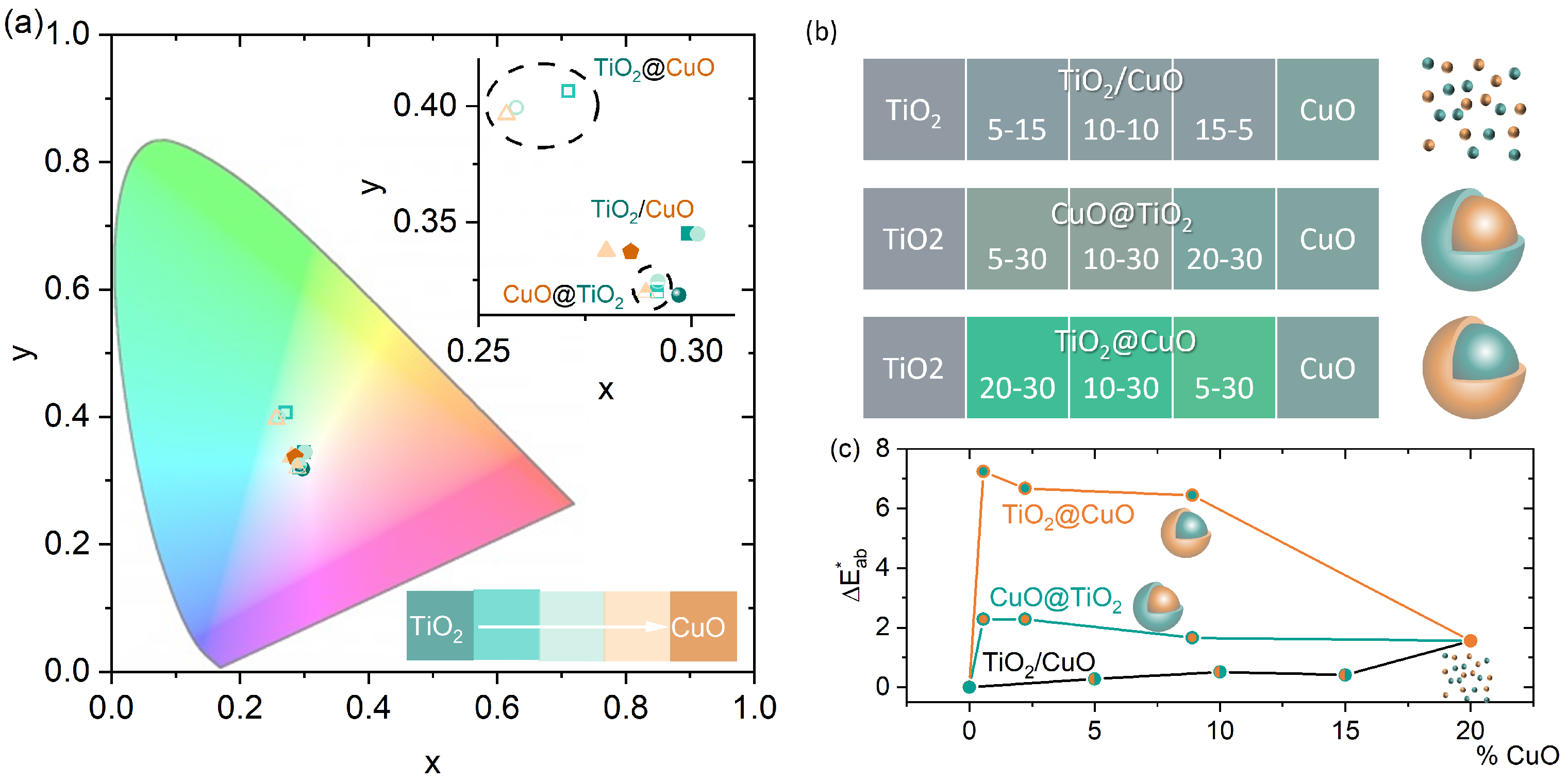Reflectance and Color Tuning in TiO2-CuO Nanoparticle Composition Mixing
Abstract
1. Introduction
2. Materials and Methods
3. Results and Discussion
4. Conclusions
Author Contributions
Funding
Data Availability Statement
Conflicts of Interest
Abbreviations
| FDTD | Finite-difference time-domain |
| IR | Infrared |
| VIS | Visible |
| UV | Ultraviolet |
| CIE | International Commission on Illumination |
References
- Buonomano, A.; Barone, G.; Forzano, C. Latest advancements and challenges of technologies and methods for accelerating the sustainable energy transition. Energy Rep. 2023, 9, 3343–3355. [Google Scholar] [CrossRef]
- Duan, H.; Chen, S.; Song, J. Characterizing regional building energy consumption under joint climatic and socioeconomic impacts. Energy 2022, 245, 123290. [Google Scholar] [CrossRef]
- Cozza, E.; Alloisio, M.; Comite, A.; Tanna, G.D.; Vicini, S. NIR-reflecting properties of new paints for energy-efficient buildings. Sol. Energy 2015, 116, 108–116. [Google Scholar] [CrossRef]
- Doulos, L.; Santamouris, M.; Livada, I. Passive cooling of outdoor urban spaces. The role of materials. Sol. Energy 2004, 77, 231–249. [Google Scholar] [CrossRef]
- Kamel, E.; Memari, A. Residential Building Envelope Energy Retrofit Methods, Simulation Tools, and Example Projects: A Review of the Literature. Buildings 2022, 12, 954. [Google Scholar] [CrossRef]
- Papadopoulos, A. State of the art in thermal insulation materials and aims for future developments. Energy Build. 2005, 37, 77–86. [Google Scholar] [CrossRef]
- Villasmil, W.; Fischer, L.J.; Worlitschek, J. A review and evaluation of thermal insulation materials and methods for thermal energy storage systems. Renew. Sustain. Energy Rev. 2019, 103, 71–84. [Google Scholar] [CrossRef]
- Veloso, R.C.; Souza, A.; Maia, J.; Ramos, N.M.M.; Ventura, J. Nanomaterials with high solar reflectance as an emerging path towards energy-efficient envelope systems: A review. J. Mater. Sci. 2021, 56, 19791–19839. [Google Scholar] [CrossRef]
- Santamouris, M.; Synnefa, A.; Karlessi, T. Using advanced cool materials in the urban built environment to mitigate heat islands and improve thermal comfort conditions. Sol. Energy 2011, 85, 3085–3102. [Google Scholar] [CrossRef]
- Rawat, M.; Singh, R. Impact of light-colored paint materials on discomfort in a building for hot-dry climate. Mater. Today Proc. 2022, 52, 998–1005. [Google Scholar] [CrossRef]
- Santamouris, M.; Yun, G.Y. Recent development and research priorities on cool and super cool materials to mitigate urban heat island. Renew. Energy 2020, 161, 792–807. [Google Scholar] [CrossRef]
- Rosati, A.; Fedel, M.; Rossi, S. NIR reflective pigments for cool roof applications: A comprehensive review. J. Clean. Prod. 2021, 313, 127826. [Google Scholar] [CrossRef]
- Bretz, S.; Akbari, H.; Rosenfeld, A. Practical issues for using solar-reflective materials to mitigate urban heat islands. Atmos. Environ. 1998, 32, 95–101. [Google Scholar] [CrossRef]
- Xie, N.; Li, H.; Abdelhady, A.; Harvey, J. Laboratorial investigation on optical and thermal properties of cool pavement nano-coatings for urban heat island mitigation. Build. Environ. 2019, 147, 231–240. [Google Scholar] [CrossRef]
- Mourou, C.; Zamorano, M.; Ruiz, D.P.; Martín-Morales, M. Cool Surface Strategies with an Emphasis on the Materials Dimension: A Review. Appl. Sci. 2022, 12, 1893. [Google Scholar] [CrossRef]
- Song, Z.; Zhang, W.; Shi, Y.; Song, J.; Qu, J.; Qin, J.; Zhang, T.; Li, Y.; Zhang, H.; Zhang, R. Optical properties across the solar spectrum and indoor thermal performance of cool white coatings for building energy efficiency. Energy Build. 2013, 63, 49–58. [Google Scholar] [CrossRef]
- Mandal, J.; Fu, Y.; Overvig, A.C.; Jia, M.; Sun, K.; Shi, N.N.; Zhou, H.; Xiao, X.; Yu, N.; Yang, Y. Hierarchically porous polymer coatings for highly efficient passive daytime radiative cooling. Science 2018, 362, 315–319. [Google Scholar] [CrossRef]
- Taha, H.; Sailor, D.; Akbari, H. High-Albedo Materials for Reducing Building Cooling Energy Use; U.S. Department of Energy Office of Scientific and Technical Information: Oak Ridge, TN, USA, 1992. [CrossRef][Green Version]
- Levinson, R.; Berdahl, P.; Akbari, H. Solar spectral optical properties of pigments—Part II: Survey of common colorants. Sol. Energy Mater. Sol. Cells 2005, 89, 351–389. [Google Scholar] [CrossRef]
- Sproul, J.; Wan, M.P.; Mandel, B.H.; Rosenfeld, A.H. Economic comparison of white, green, and black flat roofs in the United States. Energy Build. 2014, 71, 20–27. [Google Scholar] [CrossRef]
- Löf, D.; Hamieau, G.; Zalich, M.; Ducher, P.; Kynde, S.; Midtgaard, S.R.; Parasida, C.F.; Arleth, L.; Jensen, G.V. Dispersion state of TiO2 pigment particles studied by ultra-small-angle X-ray scattering revealing dependence on dispersant but limited change during drying of paint coating. Prog. Org. Coat. 2020, 142, 105590. [Google Scholar] [CrossRef]
- Gao, Q.; Wu, X.; Fan, Y. Solar spectral optical properties of rutile TiO2 coated mica-titania pigments. Dyes Pigment. 2014, 109, 90–95. [Google Scholar] [CrossRef]
- Wang, S.; Zhang, J. Effect of titanium dioxide (TiO2) on largely improving solar reflectance and cooling property of high density polyethylene (HDPE) by influencing its crystallization behavior. J. Alloys Compd. 2014, 617, 163–169. [Google Scholar] [CrossRef]
- Gao, D.; Zhang, S.; Sun, Y.; Zhou, C.; Bu, Y.; Chai, J. A novel model of mixed-particle coating for accurate performance quantifications at varying composition percentages. Int. J. Heat Mass Transf. 2022, 191, 122833. [Google Scholar] [CrossRef]
- You, Z.; Zhang, M.; Wang, J.; Pei, W. A black near-infrared reflective coating based on nano-technology. Energy Build. 2019, 205, 109523. [Google Scholar] [CrossRef]
- Baneshi, M.; Gonome, H.; Maruyama, S. Cool black roof impacts into the cooling and heating load demand of a residential building in various climates. Sol. Energy Mater. Sol. Cells 2016, 152, 21–33. [Google Scholar] [CrossRef]
- You, Z.; Zhang, M.; Wang, J.; Pei, W.; Li, G. Experimental study of optical and cooling performances of CuO and TiO2 near-infrared reflective blending coatings. Sol. Energy 2021, 225, 19–32. [Google Scholar] [CrossRef]
- Chaudhuri, R.G.; Paria, S. Core/Shell Nanoparticles: Classes, Properties, Synthesis Mechanisms, Characterization, and Applications. Chem. Rev. 2012, 112, 2373–2433. [Google Scholar] [CrossRef]
- Yao, B.; Geng, S.; Wang, J.; Wang, L. Synthesis, Characterization, and Optical Properties of Near-Infrared Reflecting Composite Inorganic Pigments Composed of TiO2/CuO Core–Shell Particles. Aust. J. Chem. 2018, 71, 373. [Google Scholar] [CrossRef]
- Hernández-Pérez, I.; Álvarez, G.; Xamán, J.; Zavala-Guillén, I.; Arce, J.; Simá, E. Thermal performance of reflective materials applied to exterior building components—A review. Energy Build. 2014, 80, 81–105. [Google Scholar] [CrossRef]
- Hernández-Pérez, I.; Xamán, J.; Macías-Melo, E.; Aguilar-Castro, K.; Zavala-Guillén, I.; Hernández-López, I.; Simá, E. Experimental thermal evaluation of building roofs with conventional and reflective coatings. Energy Build. 2018, 158, 569–579. [Google Scholar] [CrossRef]
- Oskooi, A.F.; Roundy, D.; Ibanescu, M.; Bermel, P.; Joannopoulos, J.D.; Johnson, S.G. Meep: A flexible free-software package for electromagnetic simulations by the FDTD method. Comput. Phys. Commun. 2010, 181, 687–702. [Google Scholar] [CrossRef]
- Dias, C.; Veloso, R.; Maia, J.; Ramos, N.; Ventura, J. Oversight of radiative properties of coatings pigmented with TiO2 nanoparticles. Energy Build. 2022, 271, 112296. [Google Scholar] [CrossRef]
- He, W.; Sun, H.; Zhou, Y.; Lu, K.; Xue, K.; Miao, X. Customized binary and multi-level HfO2-x-based memristors tuned by oxidation conditions. Sci. Rep. 2017, 7, 10070. [Google Scholar] [CrossRef] [PubMed]
- He, X.; Wang, F.; Liu, H.; Li, J.; Niu, L. Synthesis and coloration of highly dispersed NiTiO3@TiO2 yellow pigments with core-shell structure. J. Eur. Ceram. Soc. 2017, 37, 2965–2972. [Google Scholar] [CrossRef]



Disclaimer/Publisher’s Note: The statements, opinions and data contained in all publications are solely those of the individual author(s) and contributor(s) and not of MDPI and/or the editor(s). MDPI and/or the editor(s) disclaim responsibility for any injury to people or property resulting from any ideas, methods, instructions or products referred to in the content. |
© 2023 by the authors. Licensee MDPI, Basel, Switzerland. This article is an open access article distributed under the terms and conditions of the Creative Commons Attribution (CC BY) license (https://creativecommons.org/licenses/by/4.0/).
Share and Cite
Dias, C.; Veloso, R.C.; Ventura, J. Reflectance and Color Tuning in TiO2-CuO Nanoparticle Composition Mixing. Buildings 2023, 13, 2437. https://doi.org/10.3390/buildings13102437
Dias C, Veloso RC, Ventura J. Reflectance and Color Tuning in TiO2-CuO Nanoparticle Composition Mixing. Buildings. 2023; 13(10):2437. https://doi.org/10.3390/buildings13102437
Chicago/Turabian StyleDias, Catarina, Rita C. Veloso, and João Ventura. 2023. "Reflectance and Color Tuning in TiO2-CuO Nanoparticle Composition Mixing" Buildings 13, no. 10: 2437. https://doi.org/10.3390/buildings13102437
APA StyleDias, C., Veloso, R. C., & Ventura, J. (2023). Reflectance and Color Tuning in TiO2-CuO Nanoparticle Composition Mixing. Buildings, 13(10), 2437. https://doi.org/10.3390/buildings13102437







